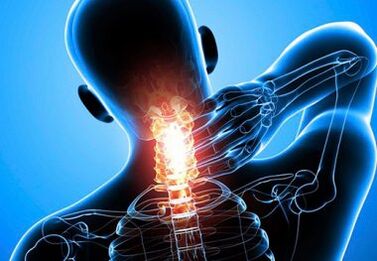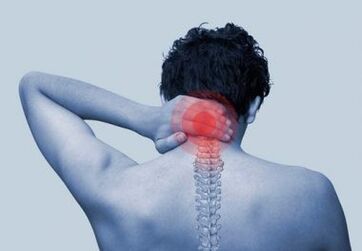Symptoms of cervical osteochondrosis are manifestations of dystrophic changes in the cartilage tissue and in the intervertebral discs. The development of pathology contributes to the subsidence and deformation of the vertebrae. As a result, the patient experiences pain, dizziness, and nausea.

Osteochondrosis of the cervical spine is associated with constant or recurring neck pain. This is the most basic symptom of cervical osteochondrosis.
The very first symptoms
The cervical spine contains the main blood vessels that supply the brain. Micro-impulses from the main organ and the central nervous system go through the nerve fibers. The severity of symptoms depends on the degree of the disease and individual characteristics. With cervical osteochondrosis, the intervertebral discs that perform the amortization function are negatively affected:
- The structure changes.
- Growths are formed in the form of ridges due to the growth of bone tissue in osteochondrosis. As a result, the blood supply deteriorates, the nerve fibers do not work properly.
The first symptoms of the disease are not expressed.

With the further development of osteochondrosis in the neck, severe pain is observed - the main symptom. During the movements, the discomfort increases and muscle tension develops.
Various groups of people are at risk. The process is determined by factors that provoke the development of cervical osteochondrosis:
- sedentary lifestyle;
- Obesity;
- accompanying pathologies - scoliosis, rheumatism;
- excessive physical activity;
- Spinal injury.
The main symptoms in the late stages of the development of osteochondrosis of the neck
Changes in cartilage tissue are manifested in the form of signs, the severity of which depends on the severity of dystrophic diseases. Processes can cause any internal body system to malfunction:
- Compression of nerve endings is characterized by symptoms in the form of osteochondrosis neuralgia. When the spinal cord becomes pinched, neurological disorders can occur. Bone growth that forms on the nerve roots partially or completely immobilizes the vertebrae, leading to their fusion. The disappearance of the sensitivity is observed.
- The compression of the main and peripheral blood vessels is the reason for the lack of blood flow. Oxygen deficiency occurs, heart function deteriorates. Symptoms of cervical osteochondrosis: frequent migraines, increases in blood pressure, incoordination, vascular dystonia, dysfunction of the respiratory tract. There can be problems with hearing and sight.
External manifestations of cervical osteochondrosis
External symptoms are characterized by a wide variety of damage to the body. Patients do not complain of a deterioration in general well-being in the pathology of the first stage. To prevent the occurrence of the disease, it is recommended to lead an active lifestyle, go swimming and do health-promoting gymnastics.

The feeling in cervical osteochondrosis of the second phase is characterized by pain syndrome, which leads to stiffness of movements.
The feeling of discomfort can be localized in different areas of the spine. The patient's performance decreases. The compression of the arteries leads to general weakness and migraines. Tilting and turning of the head increase the symptoms of osteochondrosis.
The third stage of the disease is determined by more pronounced symptoms: when palpating the pathological area, there is severe pain, immobility and movements, which are characterized by crunching, dizziness and nausea. The condition manifests itself in unconsciousness, the patient feels a lump in the throat. Violation of blood circulation leads to increases in blood pressure and high blood pressure. Numbness of the upper limbs occurs.
The fourth phase is determined by the deterioration in the condition. In the case of an advanced form of cervical osteochondrosis, the patient can become disabled. The main symptom is immobilization of the cervical vertebrae. The compression of arteries and nerve fibers reaches maximum values, which are expressed in the form of tinnitus, visual disturbances and hearing. There is a violation of language - numbness of the tongue, loss of coordination.
The treatment of osteochondrosis localized in the neck area is carried out according to a conservative therapeutic method with drugs.
The doctor prescribes physiotherapy and healthy gymnastics. To get rid of the pain syndrome during the exacerbation of the pathology, it is recommended to undergo restorative massage.
Internal symptoms and manifestations of osteochondrosis in the cervical spine
Internal symptoms characterize the changes that occur in the structure of cartilage tissue in osteochondrosis:
- Stage I of the manifestation of chondrosis. The physiological structure of the ridge is disturbed. The position of the intervertebral discs between the vertebrae narrows due to lack of fluid. Muscle hypertension occurs.
- Stage II of osteochondrosis of the neck is determined by thinning of the intervertebral discs, the height of which decreases, which increases the load on the musculoskeletal system. The result is pain.
- Stage III. Cartilage deformation occurs, proliferation of bone tissue is observed, intervertebral hernias appear, a protrusion appears. Cases of disks falling out were recorded. The symptoms of the disease are characterized by severity. The osteoarthritis begins to develop.
- Stage IV. Complete destruction of the intervertebral discs between the vertebrae by further replacement of the cavities with bone or connective tissue. The process leads to the formation of deposits.

To prevent the development of the disease, it is recommended to regularly do exercises at home that are aimed at strengthening the muscle corset in osteochondrosis. For pain relief, special drugs, ointments and injections are prescribed. Folk remedies are used in the form of compresses, bandages.
Are the symptoms different between women and men?
The neck is the most mobile part of the musculoskeletal system, it has 7 vertebrae. The division begins with the pectoral muscle and is attached to the skull. The signs of cervical osteochondrosis in women are no different from the manifestations of pathology in men. According to statistics, women are more prone to the onset of the disease, which is due to the anatomical structure and possible pregnancy.
The course of the disease depends on comorbidities, hormone levels, symptoms and other factors.
| differences | Men | Women |
| Cross section of the spine | Bigger size. | Smaller. |
| System functions | The body is exposed to constant stress. Fractures are less common due to more developed muscles. | It adapts better to loads. Osteochondrosis, curvature in the form of scoliosis, osteoporosis are often diagnosed. |
| Clinical picture | The state is characterized by stability. Lower pain threshold. Patients cannot clearly describe all signs. | The symptoms are pronounced. Patients articulate complaints clearly. |
| Age changes | The body is not subject to any restructuring of internal systems for up to 45-50 years. | Changes are observed as a result of pregnancy, hormonal changes after 45. Pain, numbness of the hands can occur. |
Carrying a fetus can be accompanied by the appearance of symptoms:
- Progression of cervical, lumbar osteochondrosis;
- Pinching of nerve endings;
- the appearance of problems with the cardiovascular system;
- Stiffness of movement.
Be sure to check out an excerpt from the popular health show. In this edition, all the main symptoms of cervical osteochondrosis are listed in detail:
Diagnosis of osteochondrosis of the cervical spine
A comprehensive diagnosis of the osteochondrosis that has occurred in the neck area, taking into account the degree of the disease and the symptoms, is the key to a favorable course of the disease. To make an accurate diagnosis, several methods are used:
- Inspection. After consulting a doctor, a visual assessment is carried out based on the parameters gait, posture. A complete history of the patient's symptoms is taken.
- Radiography is considered to be an inexpensive examination method. It is characterized by the possible occurrence of consequences that affect the general well-being of the patient. A snapshot of the cervical spine is taken from the base of the skull to the upper chest. The study shows the condition of the intervertebral discs.
- Tomography. There are two types: computed tomography and magnetic resonance imaging (MRI). In the first case, with the help of a special device, a specialist makes cuts under the influence of X-rays. The resulting image is displayed on the computer screen, a 3D model is executed. The second type of investigation is based on the work of electromagnetic waves. Layered images of a specific part of the body are recorded.

If the symptoms of osteochondrosis in the neck area are characterized by intense development, you should consult a doctor.
Prevention of osteochondrosis of the neck
To prevent the disease, it is recommended to lead an active lifestyle, do constant exercises and go swimming. With an advanced form of the pathology, treatment is prescribed, including the use of analgesic drugs that normalize the work of the internal systems of the body.
























